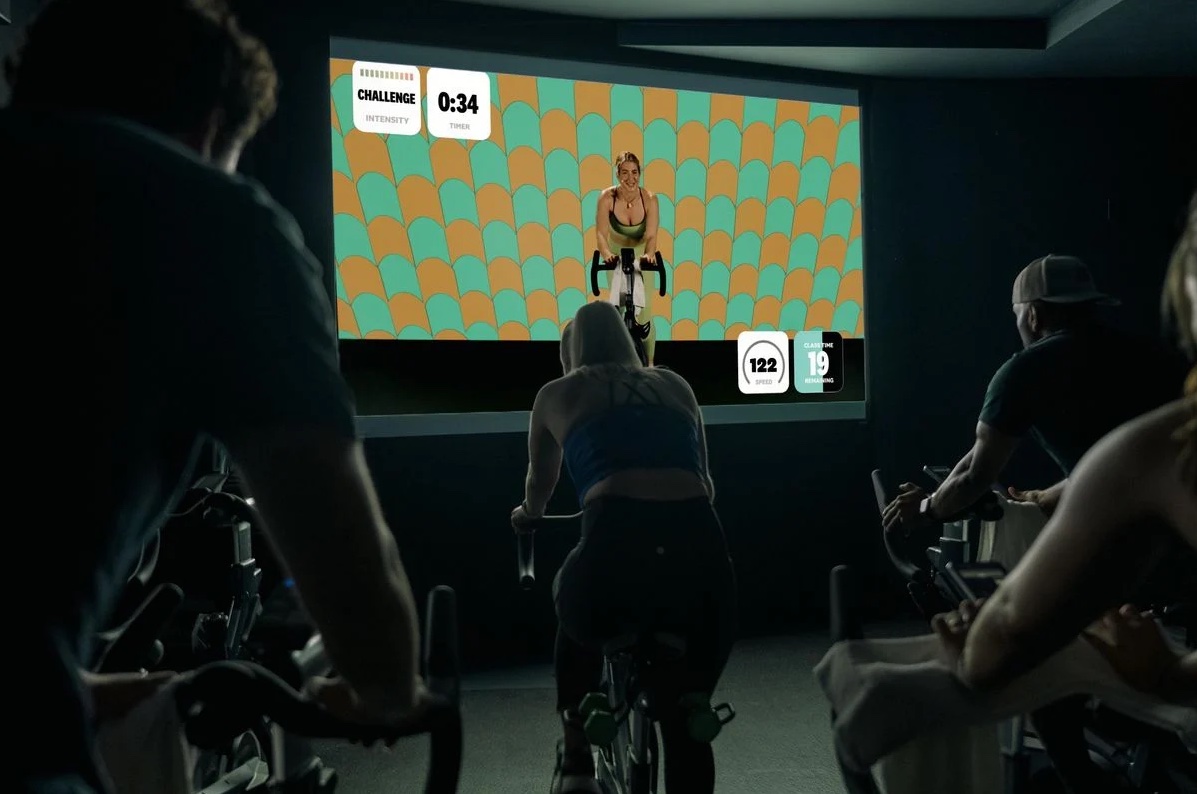In this Q&A, you’ll hear from Eric Posner, co-founder & CEO of Swerve Fitness, a content and SaaS provider for big-box gyms. Eric details how the brand went from NYC cycling studio chain to a tech-driven solution for big-box gyms to bring immersive, gamified rides to their members.
Can you tell us about what you’re working on at Swerve Fitness?
Eric Posner: Swerve is redefining group fitness as a category—starting with indoor cycling—by delivering a connected digital experience to big-box gyms nationwide.
Using our own production facilities, we package livestreamed content and connected fitness technology with two-way communication to offer existing cycling studios (within big-box gyms) an immersive, gamified class format.
In a world of leaderboards and individualized competition, our team-based approach motivates riders via competition while also building community within the room. Equipment-agnostic, our tech seamlessly connects with existing bikes at our partner gyms. The bike data is pulled in real-time, allowing each individual studio to compete against all of the other locations.
In addition to delivering a highly engaging boutique fitness experience for the consumer (at affordable prices), Swerve is simultaneously addressing key profitability problems for gyms like labor shortages, improving individual class ROI, lowering operational costs, and maximizing engagement, retention, and customer LTV.
How did you come up with the idea? What key insight led you to pursue this opportunity?
EP: We launched Swerve 1.0 back in 2013 as a brick-and-mortar indoor cycling studio (with four locations across New York City and the Hamptons). Rooted in teamwork and technology, our vision has always been about incorporating the positive attributes of team sports into a fitness experience.
But, brick-and-mortar always had its limitations to scaling, affecting our ability to impact more humans outside of New York. Additionally, even as boutique fitness boomed prior to the pandemic, we were wary of the competitive tension between studios and big-big gyms.
It wasn’t until the pandemic hit that we had our “aha! moment.” Forging a meaningful partnership between boutique fitness and big-box gyms proved to be the true whitespace in the market, so we pivoted our business into a significantly more scalable model: Swerve 2.0, a B2B content & SaaS provider offering gym members a workout experience like no other.
With the pivot, we focused on two key things: 1.) building a tech-forward product that met the needs of the evolved consumer with inclusivity and community top of mind, and 2.) building tools and technology based on our learnings as studio operators, for gym operators, with the sole focus on helping gyms drive memberships and retention.
There were a few key insights that made us take this bet.
First, the pandemic expedited consumer adoption of a virtually-led workout behind good tech and top talent. But as feelings of isolation increased, we realized what was lacking was the community, camaraderie, and energy of being surrounded by real humans. Hence our emphasis on delivering classes live, with technology that allows us to acknowledge individual and group performance in real-time, ensuring that everybody feels seen.
Though, for gyms, a lot of the new problems were the same challenges we had faced pre-pandemic as a brick-and-mortar studio: hiring, training, managing, recruiting, and scaling top talent across multiple locations (while maintaining consistency in the experience). Adding on the pandemic-driven labor shortages, price increases due to inflationary pressures, and the sunk cost of cycling studios sitting empty, gyms were given too much to handle.
While the boutique fitness model differs fundamentally from that of a big-box gym in how consumers pay (ride credits and class packages vs. memberships), it’s a known stat that big-box members who participate in group fitness have higher lifetime value than those who don’t.
As the omnichannel trend challenges gyms to sell more memberships and retain members longer, there’s an increased emphasis on delivering a top-notch group exercise experience (with multiple time offerings throughout the day). That opens up a mindset of collaboration and partnership for us.
Instead of paying the high ticket prices of a boutique fitness (upwards of $36 per class), now, big-box gym members pay that much for a membership and get unlimited Swerve classes included, plus all of the other amenities offered at participating locations.
Within our partner gyms, Swerve is accounting for upwards of 40% of group exercise bookings (this includes all other modalities and classes offered) and seeing a month-over-month retention rate in the high-80%, low-90% range.
How did you turn your idea into a company?
EP: My co-founder, John Henry McNierney, and I knew that in order to pivot our business, we were going to need to bring on experts in content, tech, and programming. We tapped Marion Roaman (Swerve’s chief content officer), Jenna Arndt (Swerve’s head trainer & VP of programming), and Natalie Ortiz (Swerve’s VP of talent) to lead the charge.
Marion was one of the pioneers of indoor cycling, operating her own studios before selling to Flywheel and then co-founding Peloton. Her leadership brings deep expertise in content, talent development, and technology.
Jenna was Swerve’s top-performing trainer in Swerve 1.0, and Natalie was a leader on Flywheel’s national talent development team. Altogether, their collective combination of expertise within digital and IRL fitness paved the way for Swerve 2.0.
In addition to a strong leadership team, we also handpicked a roster of investors and advisors to help guide our ideation and accelerate our rollout.
Namely, that includes Ellen Roggemann, previously serving CMO roles at Blink Fitness and MYXfitness; Strauss Zelnick, CEO of Take-Two Interactive, one of the world’s largest video game companies in the world; Nick Horbaczewski, founder of Drone Racing League; and Randy Kane, founding partner at Profec Partners, who has experience building and scaling a digital fitness platform.
With the new business model tee’d up, we’ve closed on over $4M in seed capital to date.
How big can this get? What’s the addressable market and how do you go about capturing it?
EP: The value proposition for gyms is compelling: to partner with Swerve requires a nominal investment in hardware (for TV, receivers, etc.) since we can tap into their existing bikes. And the ROI is proving to be immediate.
We’re excited to be a first-mover in this realm, partnering with gyms, versus competing with them, to reach a much broader audience.
The opportunity is massive given that there are over 110K gyms in the USA, and just about double that worldwide. This doesn’t include other opportunities for Swerve, such as universities, hotels, corporate gyms, apartment gyms, etc.
And cycling is just the beginning. So, as we offer additional modalities, our addressable market essentially doubles (with the ability to power other rooms within our gym partners). Plus, given the nature of our livestreamed experience, state lines or oceans are not a barrier.
By capturing a small fraction of the addressable market, Swerve can easily scale to a billion-dollar company within the next five years, if not sooner.
Who is the core customer? How are you acquiring customers? And how will you grow the customer base?
EP: Our technology allows for the experience to power any room or business that has bikes, WiFi, and a big-screen TV, but our core customer is a big-box gym.
Crunch Fitness, a brand known for innovation within group exercise, was the first to get behind our vision for partnership, signing on two NYC locations in November 2021.
Since, we’ve partnered with West Coast locations of Crunch, as well as NYSC, YouFit, XSport Fitness, and the YMCA (powering cycling studios in NY, CA, FL, and IL), with hundreds of locations in LOIs.
We’re fortunate to have very strong ROI data and high retention rates but also the operating expertise of being in our gym partner’s shoes. All of that combined is what’s closing these deals.
Notably, we have a robust deal pipeline that has been fueled entirely by our strong network of partners, not a hefty marketing investment.
Looking at your road map, what are some of the milestones you’re targeting over the next 3-6 months?
EP: We’ve only touched the tip of the iceberg with our product and experience, which is why we’re so thrilled about our early performance. In the coming months, you can expect to see considerable growth within our existing gym partners and with new gym partners coming online.
We will also be rolling out experience enhancements through more personalization and community-building technology, with further inspiration coming from the world of esports.
Anything else you’d like to share with readers?
EP: As we continue to scale our product across the US and globally, we’ll be raising capital to propel our growth. For those interested in connecting, do not hesitate to reach out.
Related reading from Fitt Insider: Issue No. 169: Fitness Comes Full Circle
If you’re interested in having your company featured in our Startup Q&A series, send an email to team@fitt.co.
 Swerve Fitness
Swerve Fitness


